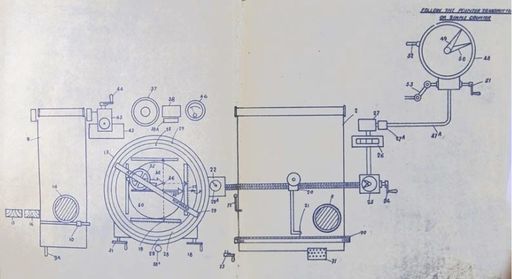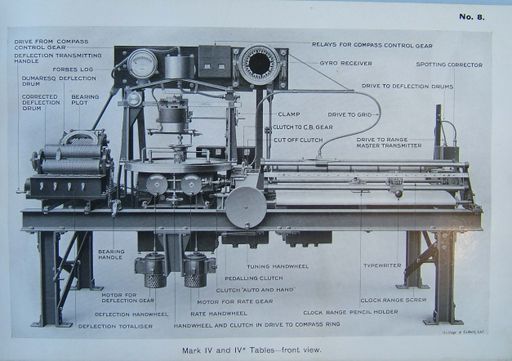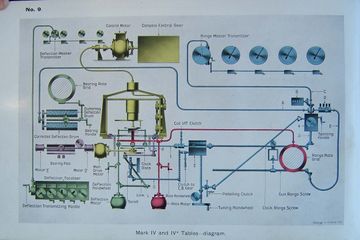Dreyer Table Mark IV

Shown with Brownrigg Keyboard and old style bearing plot and side-by-side deflection drums (though other diagrams in same source show drums arranged in same manner as the standard bearing plot.

Shown with a Standard Bearing Plot which was probably never actually used. Notice the elaborate Electrical Dumaresq which could automatically transfer rates, and the Range Typewriter which replaced the Brownrigg Keyboards the tables used until 1917.[Citation needed]
The Mark IV Dreyer Table was developed in 1914 to embody improvements that were not ready for the 5 ships that received Mark III Dreyer Tables. The prototype of the new table was installed in Iron Duke in mid-August, 1914[2]

This illustrates the Standard Bearing Plot and its Deflection Totaliser which were featured so prominently in the 1918 Handbook, but which may never have been widely deployed if at all.

This illustrates the Standard Bearing Plot and its Deflection Totaliser which were featured so prominently in the 1918 Handbook, but which may never have been widely deployed if at all.
Development
As the design of the Mark III tables was being finalised, a list of desired features draw up in February, 1913.[3] Some of the features did appear in the Mark III table, but some proved more ambitious and were embodied in the Mark IV table. Foremost amongst these were allowing the range rate and deflection on the dumaresq to be automatically applied to other components on the table: the range rate to be set on the range clock, and the deflection to devices that could convert it to a gun deflection.
The table wound up just a little bit bigger that its predecessor.
| Overall Dimensions (1918)[4] | |
| Width | 9 feet, 3 inches |
| Depth | 4 feet, 6.5 inches |
| Height of Range Rate Grid | 3 feet, 5 inches |
| Height of top of dumaresq | 5 feet, 9 inches |
Motive Power
As in the Mark III design, the table had a electric motor that drove the paper plots and the range and bearing clocks and which could fall back to a hand-crank in case of power loss.
In addition, the table needed a pair of motors to pass range rate and deflection from the electrical dumaresq. This could not be powered from the handcrank alluded to above, but in cases of power failure, they'd be declutched and their follow-up function would be assigned to human use of a pair of small hand-wheels on the lower face of the dumaresq[Citation needed].
Electrical Dumaresq
An Electrical Dumaresq replaced the Mark VI dumaresq used in the Mark III table. It was helm-free like the Mark III's dumaresq by virtue of a gyro-compass input to allow it to track own heading. Its new virtue came from the even more cumbersome assembly that dangled from its dial plate which contained contacts to electrically prompt followers in the lower housing to track the range rate and deflection indicated on the dumaresq.
Range Clock
Bearing Clock
Spotting Corrector
By 1919, nine of the 19 ships equipped with Mark IV and later tables had a worm-drive into their spotting corrector which moved the zero under the influence of a transmitter at the Dreyer Calculator. In this manner, the correction would shift the zero of the spotting corrector, and its operator could follow-up to apply it to the gun range.[5]
[TO BE CONTINUED - TONE] this largely is correct for Mark I table but not Mark IV
The spotting corrector in the 1918 handbook features:
- Output worm shaft for the plot range pencil holder
- Spotting handle to enter corrections
- Straddle correction hand (for applying corrections from a Dreyer Calculator)
- A digital Gun range counter (on the table)
- Commutator to relay gun range to control positions and conning tower
- A flexible shaft to carry gun range to the deflection drums of the standard bearing plot
A hand-worked pedalling clutch located near the tuning handle allowed the plotted range to be tuned without altering the gun range.
Range Plot
The Mark IV's range plot was much like that on the Mark III; a large surface placed on the right, with a range rate grid positioned over it.
Rate Grid The rate grid grew in sophistication by war's end, from one that had irregular markings to translate its wire angles to range rates to one with linear range rate markings, a flexible shaft to keep it aligned to the rate on the range clock, and a means of temporarily deflecting it to explore rates at variance with that set on the clock.
Plotting Range Cuts Like most of the tables, the Mark IV tables' means of plotting range cuts evolved over time. The evolution was simpler, however, because the automatic means of plotting a single RF's cuts on the Original Dreyer Table and the Mark III table was out of favor and automation was not sexy enough by itself to impede a move toward means of plotting cuts from multiple RFs even if by manual means.
After a failed effort at an automatic plotting system, it was decided to use the rather clumsy but sufficient Brownrigg Keyboard. The Mark IV tables used these through Jutland until a more elegant manual Range Typewriter was issued in 1917.[6]
Range Pencils [TO BE CONTINUED - TONE] Initial production tables had a single red pencil to plot clock range. As early drawings imply it was first installed, it appears that the tuning handle had no pedalling clutch and so intrinsically altered clock range and gun range when it was used. This implies that the tuning handle would only be used at the beginning of an encounter.
[Citation needed]
| Plotting Ranges | 2,000 - 17,000 yards (a +8,000 yard extended scale added later allowed plotting to 24,400 yards)[7] |
| Paper width | 36 inches |
| Scale | 400 yards/inch |
| Paper speed | 2 inches / minute |
The extended range scales were likely fitted to tables as opportunity around around the time (1915?) such a modification was made to ???? (Brooks)[Citation needed].
Bearing Plot
This was probably in all respects identical to Dreyer Table Mark IV*.
On plans drawn up in 1912-1913 and outlined in a Technical History drafted by Dreyer, the bearing plot was on paper 15 inches wide with a simple rate grid whose irregular edge markings as it was rotated converted the angle of rotation into a number of degrees per minute of bearing rate. By February, 1913, a single deflection drum could convert the bearing rate of the grid's inclination to a gun deflection.[8]
In Royal Oak's Mark IV* table as documented in May 1916 (probably identical to the Mark IV in all aspects except range plot), the bearing plot was to be 16 inches wide (15 inches may have been the plottable surface) with 7.5 degrees per inch to provide 112.5 - 120 degrees across its face, and using with a second drum for relating dumaresq deflection to speed-across, although these may have been arranged side-by-side and not as in the standard bearing plot.[9]
The Handbook for Capt F.C. Dreyer's Fire Control Tables, 1918 indicates that these were at some point to be provided with standard bearing plots[10], but these units received such scant service before the introduction of G.D.T. Gear that it is hard to bank that many were actually fitted.
Deployment
The Dreyer Handbook of 1918 lists five ships with Mark IV tables, with two ships crossed out and hand-written under the Mark IV* section, presumably indicating their upgrade sometime after publication. [11]
| Ship using Mark IV table | Date equipped | Notes |
| Queen Elizabeth | Upon launch through mid 1918 or beyond | updated to Mark IV* around 1918, [Inference][12] with a range plot being 7" more narrow. As Mark IV*, bore Register #23.[13] |
| Tiger | Upon launch through mid 1918 or beyond | updated to Mark IV* around 1918, [Inference][14] with a range plot being 7" more narrow. With Ramillies, this upgraded table was noted as being different from the Mark IV* majority, requiring her to be issued a pamphlet on the Mark V table. As Mark IV*, bore Register #23.[13] |
| Benbow | 1913 or earlier through mid 1918 or beyond | Updated to Mark IV* at some time between 1918 and 1930, with a range plot being 7" more narrow. As Mark IV*, bore Register #25.[13] |
| Emperor of India | 1913 or earlier through mid 1918 or beyond | Retained through 1930 without upgrade to Mark IV* range scales, Register #9.[13] |
| Iron Duke | 1913 or earlier through Jutland at least[Citation needed] | Updated to Mark IV* at some time between 1918 and 1930, with a range plot being 7" more narrow. As Mark IV*, bore Register #17.[13] |
| Vernon | Between 1918 and 1930.[15] | Possessed one in 1930.[13] |
| Defiance | Between 1918 and 1930.[16] | Possessed one in 1930.[13] |
Wartime Innovations
In early 1916, Queen Elizabeth and Barham had tweaked their bearing plots in some manner which "increases the value of the bearing plot considerably."[17]
Also in early 1916, a modification to permit ranges to 25,00 yards required new pieces in the spotting correction counter gear, perhaps to allow the 10,000 digit to go to "2". These apparently required some caution in their installation and adjustment.[18]
Postwar Modernisation
The need to achieve longer ranges prompted the updating of Mark IV tables to the 28,000 yard limits of the similar Mark IV* family when the tables were made available for overhaul. The upgraded tables were very similar to the stock Mark IV* tables except in that their range plots were 7 inches more narrow.[19]
See Also
Footnotes
- ↑ Admiralty. Captain F. C. Dreyer's Fire Control Apparatus Mark IV, as fitted in H.M.S. Royal Oak, May 1916, Figure 1.
- ↑ Brooks. Dreadnought Gunnery and the Battle of Jutland. p. 169.
- ↑ Dreyer & Usborne. Technical History, pp.47-8.
- ↑ Dreyer Handbook, 1918 p. 90.
- ↑ Reports of the Grand Fleet Dreyer Table Committee, 1918-1919, p. 8.
- ↑ Brooks. Dreadnought Gunnery, p. 173.
- ↑ Dreyer Handbook, 1918 p. 17.
- ↑ Pollen Aim Corrector System, Part I. Technical History and Technical Comparison with Commander F. C. Dreyer's Fire Control System, pp. 47-8.
- ↑ Captain F. C. Dreyer's Fire Control Apparatus, Mark IV, Sheet 11, Fig I.
- ↑ Handbook for Capt F.C. Dreyer's Fire Control Tables, 1918. pp. 13-15.
- ↑ Handbook of Capt. F.C. Dreyer's Fire Control Tables, p. 3.
- ↑ Crossed out under one heading and pencilled in under the other in Dreyer Handbook
- ↑ 13.0 13.1 13.2 13.3 13.4 13.5 13.6 Admiralty. Pamphlet on the Mark IV* Dreyer Table, 1930, p. 6.
- ↑ Crossed out under one heading and pencilled in under the other in Dreyer Handbook
- ↑ Not mentioned in Dreyer Handbook, mentioned in Mark IV* Pamphlet of 1930.
- ↑ Not mentioned in Dreyer Handbook, mentioned in Mark IV* Pamphlet of 1930.
- ↑ Grand Fleet Gunnery and Torpedo Orders. No. 139.
- ↑ Grand Fleet Gunnery and Torpedo Orders. No. 130.
- ↑ Admiralty. Pamphlet on the Mark IV* Dreyer Table, 1930, p. 6.
Bibliography
- Admiralty, Gunnery Branch (1918). Handbook of Captain F. C. Dreyer's Fire Control Tables, 1918. C.B. 1456. Copy No. 10 at Admiralty Library, Portsmouth, United Kingdom.
- Brooks, John (2005). Dreadnought Gunnery and the Battle of Jutland: The Question of Fire Control. Oxon: Routledge. ISBN 0714657026. (on Amazon.com and Amazon.co.uk).
- Brooks, John (2001). Fire Control for British Dreadnoughts: Choices of Technology and Supply. Unpublished PhD Thesis. London: Department of War Studies. King's College, London.
- Dreyer, Frederic; Usborne, Cecil through Gunnery Branch, Admiralty. (1913). Pollen Aim Corrector System, Part I. Technical History and Technical Comparison with Commander F. C. Dreyer's Fire Control System. P. 1024. in Admiralty Library, Portsmouth.
- Elliott Brothers, London (1916). Captain F. C. Dreyer's Fire Control Apparatus, Mark IV. Copy 19 "as fitted in H.M.S. Royal Oak" at H.M.S. Excellent Library, Portsmouth, United Kingdom.